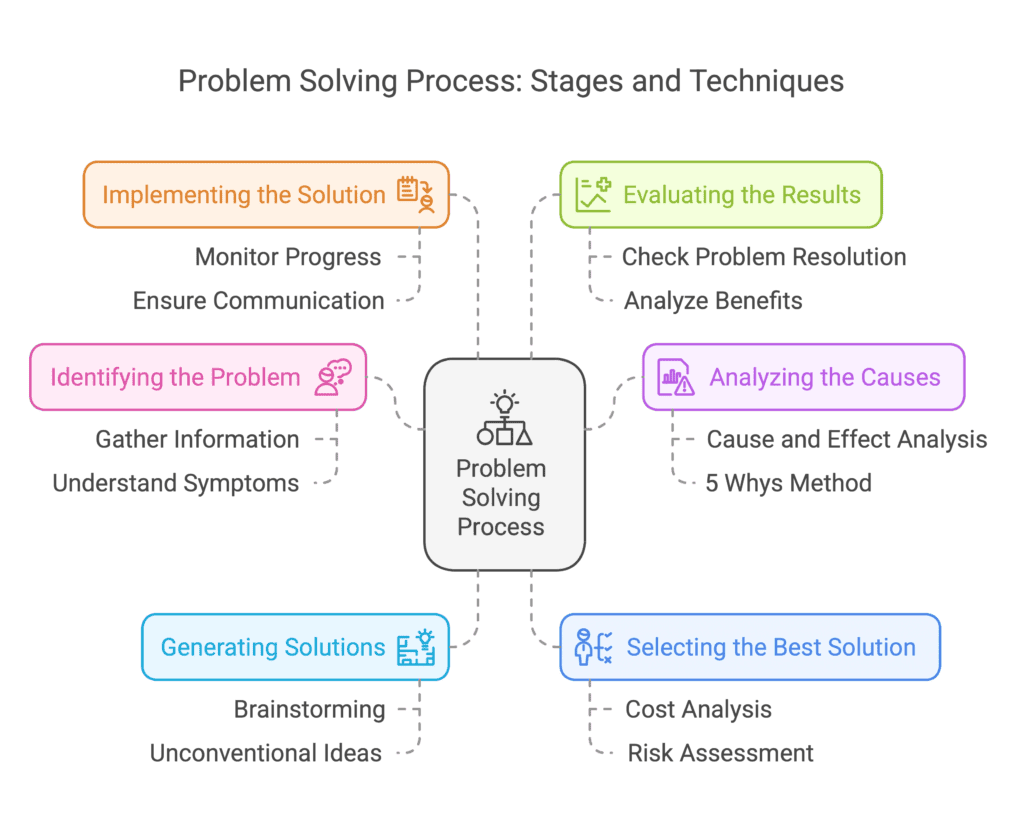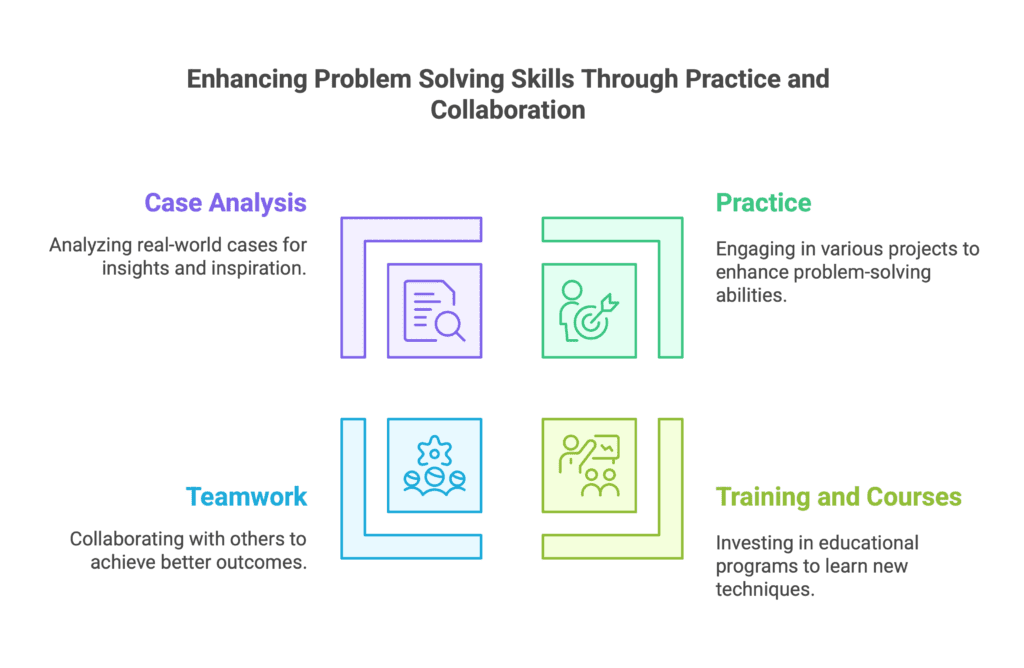Regardless of whether we are producing a product or a service, problem solving is crucial for effectiveness. In every organization, regardless of the industry, problems arise almost daily and can take various forms — from minor production defects to major issues escalated by customers.
From this article, you will learn what problem solving really is, which techniques and tools are worth using, and how to develop this skill in the context of working in the quality department. The article is aimed at everyone associated with this department, who daily faces challenges that require not only analytical thinking but also making quick and effective decisions.
What is Problem Solving?
Problem solving is a process that includes identifying the problem, analyzing its causes, and then developing and implementing effective solutions. In the context of the quality department, this skill is particularly important. Why? Because it directly impacts the quality of products and services, as well as customer satisfaction.
However, the process does not end with merely solving the problem. It is equally important to monitor the implemented actions and analyze whether they have produced the expected results. Often, problem solving requires an iterative approach, where each subsequent iteration brings us closer to the final solution.
This involves cyclically repeating certain steps or stages. Instead of striving for a one-time, perfect solution, the iterative approach allows for continuous improvements as the problem becomes better understood.
In practice, this means that after the initial implementation of the solution, its effects are analyzed, and then adjustments or additional changes are made to achieve an even better resolution. Each subsequent iteration thus brings us closer to achieving optimal results.
Why is this approach useful?
Because problems often have multiple complex causes, and an effective solution may require many attempts and modifications. This way, you can react in real time to new information and quickly adapt solutions to changing conditions.
Steps in the Problem Solving process
The problem solving process can be divided into several key stages that help organize actions and increase effectiveness in solving problems.

1. Identifying the problem
The first step is to precisely identify the problem. It is important to note that the symptoms of the problem may often differ from its actual cause. For example, a decline in product quality may be caused not only by production errors but also by issues with suppliers of subcomponents or raw materials.
In this phase, it is essential to gather as much information as possible to help understand exactly what we are dealing with. This could include production data, employee opinions, quality reports, as well as complaints or feedback from customers.
2. Analyzing the causes
After identifying the problem, the next step is to analyze its causes. One of the most popular methods used for this purpose is the cause-and-effect analysis, known as the Ishikawa diagram (fishbone diagram). This method allows for a graphical representation of possible causes of the problem, making them easier to identify.
Another technique that can be useful at this stage is the 5 Whys method. It involves asking the question “why?” (usually five times, but this is not a rule) to reach the root cause of the problem.
3. Generating solutions
Once we know the causes of the problem, we can proceed to generate possible solutions. At this stage, it is worth using creative thinking methods, such as brainstorming, which allows all team members to freely express their ideas.
It is important not to reject any ideas at this stage, even if they seem unrealistic at first glance. Sometimes the most unconventional solutions turn out to be the most effective.
4. Selecting the best solution
After generating a list of possible solutions, they need to be evaluated, and the one that best addresses the identified problem should be selected. Evaluation criteria may include factors such as implementation costs, time required for execution, or the potential risk associated with a given solution.
It is also worth creating an action plan that includes all the steps necessary to implement the chosen solution and assigning responsibility for each task.
5. Implementing the solution
After selecting the best solution, the implementation phase follows. This is the moment when theory is put into practice. In this step, it is crucial to monitor progress and respond promptly to any difficulties. Often, the implementation of the solution requires the involvement of various departments within the organization, so communication and collaboration are extremely important here.
6. Evaluating the results
The final stage of the problem solving process is evaluating the results of the implemented solution. This involves checking whether the problem has been fully resolved and analyzing whether the implemented actions have brought the expected benefits. It is also worth considering what lessons can be drawn from this process to avoid similar problems in the future.
Tools supporting Problem Solving
In the problem solving process within the quality department, it is crucial to use appropriate tools and techniques that can significantly facilitate work and increase the effectiveness of actions. Here are a few of them:
1. Ishikawa Diagram
The Ishikawa diagram, also known as the fishbone diagram, is one of the most popular tools for analyzing the causes and effects of problems. It allows for the organization of all possible causes of a problem in a graphical manner, making them easier to identify and analyze.
2. 5 Whys Method
The 5 Whys method is simple but extremely effective. It helps to get to the root cause of the problem by asking the question “why?” five times. This tool is particularly useful in situations where the problem has multiple layers, and it is difficult to immediately identify its main cause.
3. Six Sigma
Six Sigma is a quality management method that focuses on eliminating defects and process variability. Within Six Sigma, practitioners use various statistical tools and analytical methods to support the problem solving process. This method is especially useful in large organizations where maintaining high quality at every stage of production is crucial.
4. PDCA (Plan-Do-Check-Act)
PDCA, also known as the Deming Cycle, is a tool that supports the process of continuous improvement. It consists of four stages: planning (Plan), implementation (Do), checking (Check), and action (Act). It is an iterative approach that allows for systematic problem solving and process improvement.
How to develop Problem Solving skills?
You can and should develop the skill of effective problem solving. Here are a few tips that can help in improving this competence:
1. Practice
The best way to develop problem solving skills is through practice. It is worth getting involved in various projects that require problem solving, even if they are not directly related to your area of responsibility.
2. Training and Courses
There are many trainings and courses that focus on developing problem solving skills. It is worth investing in such training to expand your knowledge and learn new techniques and tools. In our offer, you will find the 8D Problem Solving training, performed by experienced professionalist and practitioner.
3. Teamwork
Solving problems as a team often leads to better results than working individually. Collaboration with others allows for the exchange of ideas and experiences, which can lead to more innovative and effective solutions.
4. Case Analysis
Case studies are an excellent tool for learning problem solving. Analyzing real cases that have occurred in other organizations can provide valuable insights and inspiration for solving your own problems.

Summary
The ability to solve problems is extremely valuable, especially in the quality department, where every problem can have a direct impact on the quality of products and customer satisfaction. This process includes several key stages, from identifying the problem, through analyzing causes, to implementing and evaluating solutions.
Using appropriate tools and techniques, as well as continuously improving your skills, can significantly increase effectiveness in solving problems.
For those working in quality, developing problem solving skills is not only crucial for professional success but also ensures that the products and services offered by the company meet the appropriate quality standards.
It is therefore worth investing time and resources in improving this skill to be prepared for any challenge that may arise.
Dariusz Kowalczyk


